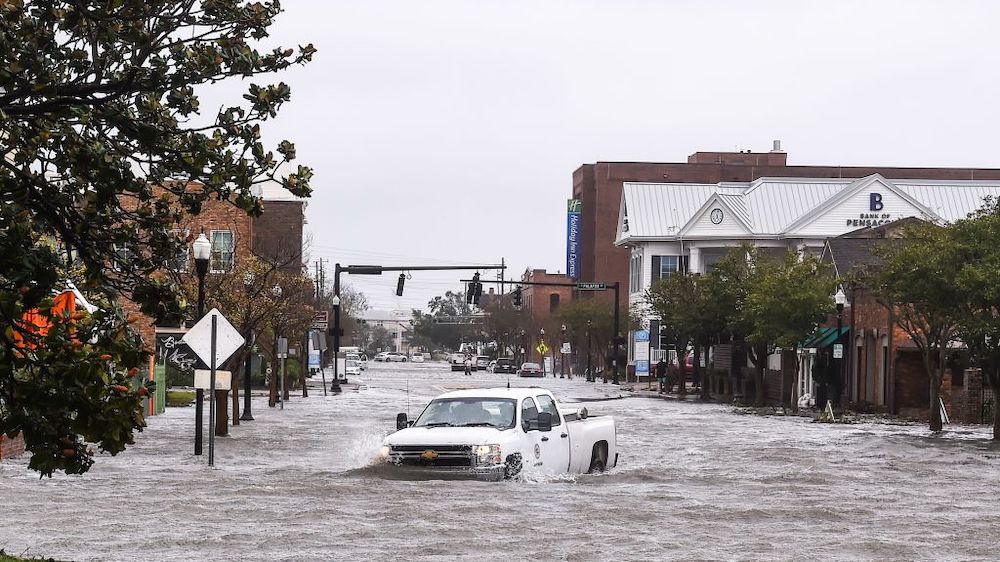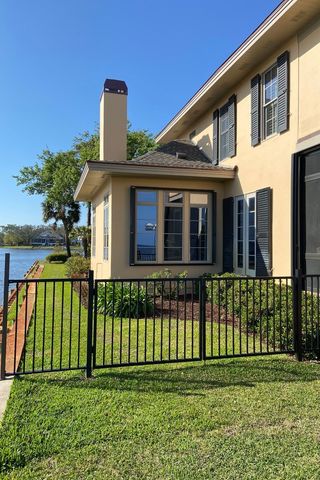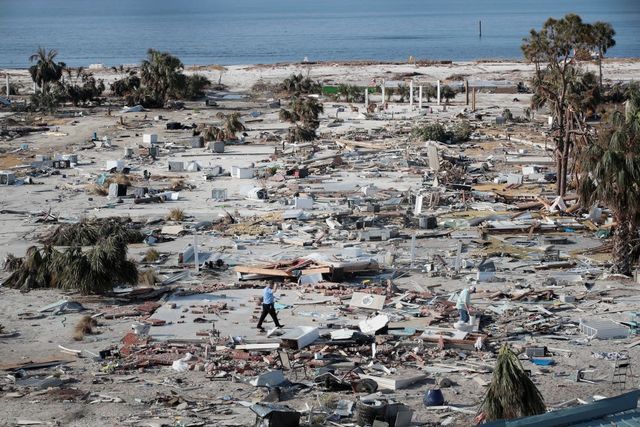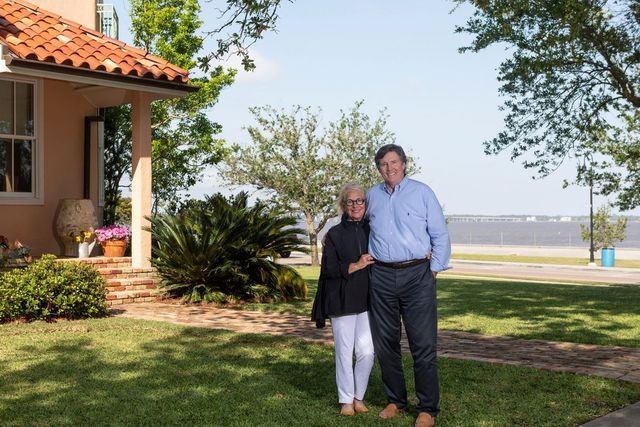
Chandan Khanna/AFP via Getty Images
Calvin and Elizabeth Moore weren’t worried when they learned their coastal Pensacola, Fla., home was in the path of Hurricane Sally. They had upgraded its roof and windows after Hurricane Ivan damaged the property in 2004.
But the 2020 storm was stronger than expected, and they ended up with significant damage from a leaking roof, said Mr. Moore, 79, a retired real-estate broker. They were able to have their antiques, art and furniture safely removed and stored while workers repainted and dealt with mold inside the house. They spent months sleeping in the sitting area off their kitchen.
To cover the roughly $300,000 in repair costs on their 4,000-square-foot home, which faces the water on three sides, the couple added their own funds to payouts from the insurer they finally switched to after the previous storm and after a second insurer they picked stopped covering their area. Their $1.5 million Pure policy, including a rider for flood damage, covered about $200,000 in damages. Mr. Moore said he paid a $37,000 wind deductible to the builder and plans to spend $70,000 to repair his torn-up backyard, which isn’t covered.

Calvin Moore
“It’s a work in progress,” he said.
The Moores were diligent about adequate coverage, which costs them about $28,000 annually. The typical home-insurance policy doesn’t always cover costly storm damage, such as flooding, for high-end coastal and waterfront properties. Many luxury homeowners, like the Moores, are turning to a small but growing sector of private insurers that offer additional policies to fill the gaps.
“It’s a very bad experience for consumers; a lot of houses [are] put into unfair situations,” says Nick Steffey, chief executive of ShoreOne Insurance Managers in Dedham, Mass. The company, launched in 2019, offers coastal homes flood insurance, typically as a supplement to their homeowners policy.
Currently, most homeowners in FEMA-designated flood zones get coverage through the National Flood Insurance Program, managed by the Federal Emergency Management Agency. It covers up to $250,000 in damages. FEMA makes additional funds available if a disaster is declared.
The program cap, however, means high-end homeowners are often left with significant out-of-pocket costs. Many also end up underinsured because FEMA’s risk estimates can ignore damage from nearby bodies of water or from strong storms, says Jeremy Porter, head of research and development at First Street Foundation, a nonprofit that advocates for more transparency in flood risk and climate change.

Scott Olson/Getty Images
“One of the biggest problems is assessing flood risk,” said Dr. Porter. In the next 30 years, economic damage due to changing environmental conditions is estimated to jump to 7.5 times the current average insurance payout, up from 4.5 times, according to data from First Street Foundation.
Tom and Kim DiBacco spent months working with Tower Hill, their insurance company, on repairs to their 6,000-square-foot Panama City Beach, Fla., home after 160 mph winds from Hurricane Michael blew off their chimney, letting water inside. The exterior damage to the home, which is valued at $1.3 million, included having to replace parts of their pool, said Mr. DiBacco, 58, a wine and spirits distributor, who bought the home in 1997 for $515,000.
“This was not welcome,” he said. “It was kind of a frenzy.”
The couple already had replaced the roof and flooring after a 2016 storm. Those repairs included converting a study to a wine cellar.
After negotiating over their insurance, which had separate riders for flood and windstorm coverage, the couple received nearly $245,000 for damages, including living expenses when they had to move out of their house while work was completed. They rebuilt the fireplace and wall that had shifted in their two-story living room, installed new windows and repaired the water damage in the home’s main bathroom.

Jacqueline Marque for The Wall Street Journal
Since then, the couple’s insurance annual premium has increased 30% to about $9,000, he added.
High-end homes have additional challenges with policies, says Bo Williamson, a public adjuster in Panama City Beach, who worked with the DiBaccos. “There’s a huge disconnect in the cost of repairing high-end homes,” he said.
For one, he said, insurers often fail to account for true replacement costs for costly finishes. They also may dispute coverage where there are multiple causes of damage, such as wind, flooding and fire. He suggests owners make videos to document their home’s condition before any event occurs.
When Hurricane Harvey made landfall in 2017, Laura Manchee’s 1950s single-story home in Bellaire, Texas, was entirely destroyed by flooding. She combined NFIP insurance and a $60,000 policy on contents to jump-start the recovery process and get a sort of down payment for her plans to rebuild bigger and better. Agreeing to elevate the new home 53 inches above the floodplain allowed her to get additional insurance at a lower rate, she said.
The interior designer spent two years rebuilding the home, which is now more in line with the newer million-dollar homes in the neighborhood, she added. The family of four upgraded their space to three bedrooms across 3,900 square feet, compared with their 1,400-square-foot original.
“We really liked a modern prairie-style aesthetic,” says Ms. Manchee, who installed a stained-glass window from the living room in the original postwar home on the new home’s second floor. She declined to estimate her construction costs.
Her annual flood insurance under NFIP, which included home contents, cost her $1,800 for her previous house, but her annual costs dropped to $600 for the same coverage in her new home because of its elevation.
In response to high demands, many insurers are expanding their services and getting more specialized, said Ross Buchmueller, chief executive of Pure Insurance. They offer to speed connections to roofers, mold mitigators, energy generators and alternative housing when the need for services in an area soars.
“The complexity is much greater when every [claim] is happening at the same time,” said Mr. Buchmueller. Pure recently acquired an art-curation company to help clients better protect expensive pieces during a storm, he added.
“We really liked a modern prairie-style aesthetic,” says Ms. Manchee, who installed a stained-glass window from the living room in the original postwar home on the new home’s second floor. She declined to estimate her construction costs.
Her annual flood insurance under NFIP, which included home contents, cost her $1,800 for her previous house, but her annual costs dropped to $600 for the same coverage in her new home because of its elevation.
In response to high demands, many insurers are expanding their services and getting more specialized, said Ross Buchmueller, chief executive of Pure Insurance. They offer to speed connections to roofers, mold mitigators, energy generators and alternative housing when the need for services in an area soars.
“The complexity is much greater when every [claim] is happening at the same time,” said Mr. Buchmueller. Pure recently acquired an art-curation company to help clients better protect expensive pieces during a storm, he added.
———
Using risk tools
Buyers are often in the dark about their new property’s flood risk. But new tools are available to help understand risk assessment for properties, and to find flood coverage. But it can cost you.
Last year, the First Street Foundation, a nonprofit, launched Flood Factor, a model that takes into account the widespread nature of flood risk. It estimates there are roughly 70% more properties at risk for flooding than those found by FEMA. Homeowners can search the site by entering their address.
Most buyers and mortgage lenders rely on FEMA’s Flood Insurance Rate Map to assess flood risk. Lenders often require buyers in those designated zones to get flood insurance.
Technology advancements, including higher resolution topographic imagery, is making it easier to understand risk, says Nick Steffey, chief executive of ShoreOne Insurance Managers in Dedham, Mass.
This fall, FEMA will roll out its Risk Rating 2.0, a flood-insurance overhaul that will increase rates for many high-end homeowners under the National Flood Insurance Program. Instead of relying on a property’s elevation within existing flood maps, the new methodology also incorporates variables such as flood frequency, flood types such as river overflow and distance to a water source, said a FEMA spokesperson.
Tony Rodriguez-Tellaheche, co-founder of Prestige Realty Group in Miami, advises his buyers to discuss flood insurance with independent agents to better assess their risk. He refers clients to an agent at the start of the purchasing process, because the additional premium gives a more realistic view of how much it will cost the maintain the home.
“Buyers need to be aware and ask what these flood costs are up front,” he says.
The post Waterfront Homeowners Weather High Insurance Costs After Major Storms appeared first on Real Estate News & Insights | realtor.com®.
